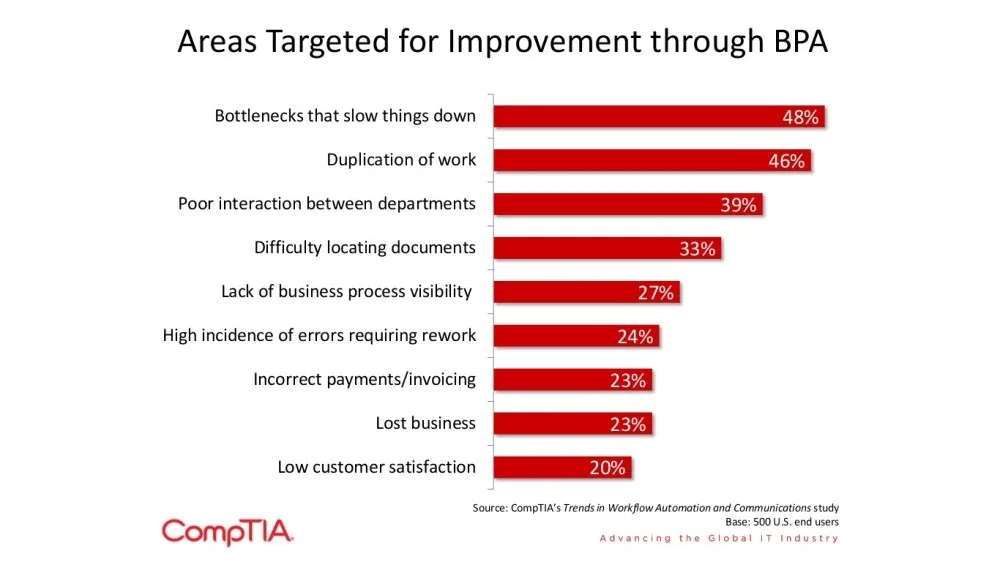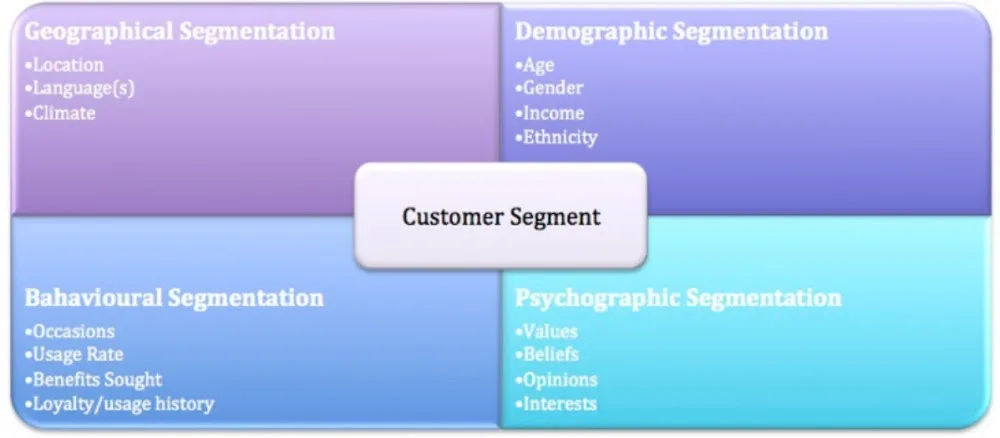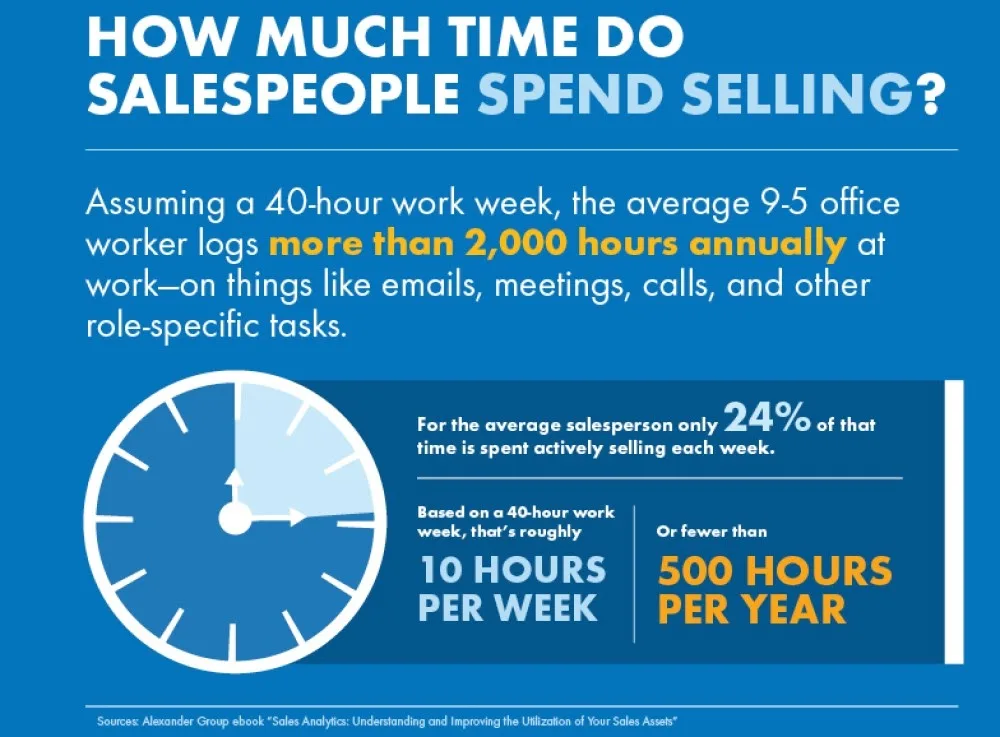16 Workflow Automation Ideas for Ecommerce Businesses
Nick Shaw


16 Workflow Automation Ideas for Ecommerce Businesses
Get The Print Version
Tired of scrolling? Download a PDF version for easier offline reading and sharing with coworkers.
A link to download the PDF will arrive in your inbox shortly.
The ecommerce industry is booming. According to Statista, it was worth $3.535 billion at the end of 2019. That’s after year-on-year growth that saw revenue rise from $1.336 billion as recently as 2014. There’s no sign of growth slowing — let alone leveling off — in the coming years.
In a growing sector, businesses have plenty of opportunities for development. By taking a closer look at its processes, an ecommerce firm can get a more significant slice of the market. Workflow automation is a smart way for a firm to boost their bottom line.
Websites operate 24/7. You can take orders every hour of the day and every day of the week. Only the very largest companies can have staff working the same hours. For all the rest, automating key processes keeps the business ticking when your staff aren’t present.
If that sounds like something your brand needs, you’ll want to read on. We’re going to cover ecommerce automation from all angles. You’ll learn what workflow automation is and how it could benefit you. Then, we’ll share a selection of the most useful ways you may be able to automate your business processes.
What Is Workflow Automation?
Workflow automation is a way for businesses to streamline their processes.
The central premise is to identify repetitive tasks or any manual process that could be better handled by software, apps, or tech. You then take those tasks out of your employees’ hands. Rather than wasting valuable staff-hours, you get the same jobs done automatically.
There are processes across all departments of your business that can be automated. From inventory management to email marketing or human resources, ecommerce automation can improve processes across the board.
We’re going to share loads of ideas for how you might join the streamlining party. First, though, let’s talk about precisely why you want to do so.
Why Use Workflow Automation for your Ecommerce Site?
As a small business owner, you need to understand and become an expert in numerous business processes. There are three main ways in which workflow automation can help you to do so.
1. Efficiency.
Many ecommerce tasks are mundane and repetitive. It doesn’t make them any less essential.
What it does mean, however, is that if a human must do them, they’re tremendously time-consuming. Take order management, for instance. That area of your business may require a lot of data entry. You may also need to send dispatch emails to customers and print shipping labels. Order management software can automate the entire process.

Source: CompTIA
Repetitive tasks create bottlenecks in your operations. Rather than have work progress smoothly, it slows to a crawl as the time-intensive jobs get done. A workflow automation solution can open up those bottlenecks. The mundane tasks get automated and completed in far less time. You’ll then see an uptick in efficiency across your organization.
2. Data and task accuracy.
In ecommerce, lots of data gets generated. Order details, customer information, and stock numbers are just a few examples. To keep things running smoothly, your business must enter and store the data in a variety of systems. Before ecommerce automation, all data had to be inputted and shared by hand.
Where humans are involved, so is human error. Even the most competent and attentive worker will make occasional mistakes. Those simple errors can snowball into significant problems. Incorrect recording of stock, for instance, can see you fail to fulfill vital orders. With workflow automation, such mistakes get taken out of the equation.
With the best automation tools, the chance of negative customer service due to human error can get reduced by as much as 65%.
3. Productivity.
You might feel a little worried that what we’ve described so far is a way to put your staff out of a job. That couldn’t be farther from the truth.
Automation tools let you get the most from workers, and use them as productively as possible. Workflow automation is about superior business process management (BPM), not laying off workers.
When you automate crucial but repetitive processes, staff can focus on other things. They can give their attention to tasks that need intelligence and personal service. Automation gives them more time to design new products. It frees them up to nurture relationships or interact with customers. Your business productivity, therefore, will rise considerably.
Ecommerce Tasks For Workflow Automation
Online retailers have an abundance of choice when it comes to tech to aid automation. This recent retail tech stack report provides an in-depth breakdown. We’re going to help you better understand how to automate repeatable processes or manual tasks. The following are seven business areas to which our workflow automation ideas apply:
Customer experience and support
Marketing
Purchase order approvals
Vendor and supplier onboarding
Order management
Inventory
Sales
Automate Customer Experience and Support
Lots of firms in the ecommerce niche — and in other fields — are looking for ways to stand out from the crowd. Many are turning to customer experience (CX) as a differentiator. Improving interactions through the customer journey is a great way to boost loyalty. Here are five ideas for workflow automation to improve CX.
1. Track and reward your most engaged customers.
For all types of businesses, customer retention is critical.
The probability of selling to an existing customer is much higher than that of selling to a new prospect.
One of the best ways to boost retention is by rewarding customers for their loyalty.

Source: Invesp
You can leverage some simple automation to track and reward engaged customers. Smart workflow automation tools let you tag customers based on what they’re buying. You can then set business rules to send targeted marketing to people who reach a certain order value or number of purchases. You might, for example, automatically send a discount code by email to a customer who’s spent over $200.
2. Sync your customers to an email list.
Email marketing is vital to ecommerce businesses. Strategic, targeted email campaigns are an excellent way to generate more sales. Most firms use a dedicated platform for their email marketing. If you do, it’s simple to automate workflows to make the process frictionless.
The best way to automate processes in this way is by syncing an email client with your CRM system. That way, you can ensure you segment your email list as effectively as possible. Take, for instance, a prospect who shows an interest in a particular product. You can get them automatically added to a relevant email list.
Those customers will then get targeted marketing material relevant to their interests. The kind of content will increase the conversion rate from prospect to customer. We’ll talk more about general marketing automation a little later on.
3. Gather feedback after a purchase.
If you’re going to improve CX, you must first understand your customers’ perception of your products. The best way to assess this is by simply asking them. Seeking customer feedback is how successful brands identify their weaknesses. Only then can they act to improve them.
You can streamline workflows to collect that feedback automatically. Once again, this involves creating automated emails. With a workflow automation tool, you can send follow-up emails. They’ll go out at a specified time after a sale. These automated emails show customers that you value their feedback. Over 40% of customers don’t leave feedback because they don’t believe a business cares.
4. Reach out to negative reviews.
Customers who leave feedback unprompted are more likely to offer negative reviews. It’s human nature to register dissatisfaction more readily than contentment. When your firm does get a negative review, it’s vital that you respond. Doing so shows the complainant and other customers that you care about solving problems.
Workflow management via automation ensures that no negative review will slip through the cracks. Say, for instance, that reviewers give your brand a rating out of five stars. You can establish an automated process that identifies all reviews with two stars or fewer. You can then have the reviews automatically referred to a customer service team member.
5. Tag and segment customers based on buying behavior.
Analyzing and tracking customer behavior will help you tailor CX. A vital element of monitoring customer behavior is segmenting your list. What that means is dividing your patrons by their characteristics. You might segment them by age, gender, or order value, for example.

Source: Builtvisible
Segmentation helps improve your service to different kinds of customers. It’s a process that you can fully automate with intelligent workflow tools. The information required is all in your order management or CRM systems. Automation tools can use it to segment customers in a variety of ways, all without need for staff input.
Workflow Automation and Marketing
Improving CX via automation is about customer retention. Something else online stores have to focus on is acquisition. Only by winning new customers can a firm grow and flourish. Customer acquisition is the central priority of any brand’s marketing. There are ways to improve that vital area of your business with workflow automation, too.
1. Schedule social media posts automatically.
Social media is a potent marketing channel for ecommerce businesses. The number of global users of social networks is vast and climbing. 54% of social media users research products via their preferred platform.
It’s no surprise, then, that online retailers give so much time and attention to social media marketing. Effective social media marketing is an ongoing process. You need to continually create and share content that engages your audience.
With process automation in this area, your firm can reap the rewards of social media presence without having to devote so many staff-hours. There are loads of web apps or other tools out there to automate your social media. You can create posts en masse and then use tools to schedule when and how they’re distributed.
2. Nurture leads with continual marketing.
The customer journey comprises many touchpoints. Not all customers will visit your site, find a product, and buy it right away. Some may come back several times. In between, they may spend time researching and considering the purchase.
If you have their contact details and permission to reach out, you can help sway their decision. That’s the principal idea behind lead nurturing.
Automated lead nurturing works in a similar way to customer retention via email. You can set up a process by which prospects get sent useful, persuasive content. Pitch the content right and send it periodically, and you can turn a wavering lead into a customer.
Things you may consider including in marketing content can vary. It could be discount codes or informational posts to overcome objections. The best way to decide is by collecting real-time data on customer behavior and going from there.
Purchase Order Automation
Even what may seem like a more complex area of your business can benefit from automation. Think about how you order inventory from suppliers. At a certain point, you decide that you need more stock. Then, you raise a purchase order with your preferred supplier and arrange for them to deliver. There’s no reason that the whole process can’t get automated.
With automation, you can get purchase orders raised according to incoming sales. When a purchase reduces your stock to a predetermined level, the order can be generated automatically. You can even create rules about first choice suppliers for different items.
Purchase order tracking is also more straightforward with automation. You don’t have to flip between stock sheets, emails, and other documents. Everything gets done within one management system.
Vendor and Supplier Onboarding
Change is something that can always lead to disruption in the business world. A prime example is when you have to switch vendors or add a new supplier. There’s lots of information to share between your firm and that which you’ll be working with. You’ll need to exchange payment and tax details. Often, you’ll also have to get a new supplier up to speed on your systems and procedures.
All that takes time. If you devote a team member to doing it, you’ll lose out on what that worker would usually be doing. An automated supplier portal can take that burden away from your workers. You can share and receive all details pertinent to a vendor relationship via a web-based interface. It’s quicker, more accurate, and lets your team stay productive in other areas.
Workflow Automation for Order Management
Order management is a catch-all phrase for a vital element of online store operation. It’s the process by which customers’ orders get tracked and progressed from start to finish. It’s a business process that overlaps project management, customer service, and many other areas. From order placement to post-sale, many business processes can get automated.
1. Shipping labels.
The dispatch and delivery of orders is a crucial element of every ecommerce business. Failed deliveries can be a huge expense in the long run. Often, problems with distribution are down to small mistakes along the way. A worker might mistype an address on a shipping label, or an order could be incorrectly recorded in your system as complete.

Source: Shiptheory
Workflow process automation streamlines this part of your business, making it much faster and more efficient. Implementing automation means you can get multiple tasks done with a single click. That includes printing your shipping labels and accurately marking orders as dispatched. It can also encompass creating tracking numbers for deliveries.
2. Send reminders for customers to reorder.
Your contact with customers shouldn’t end after a single purchase. Post-sale support and continued marketing are vital. If you sell particular products, too, there’s another essential process to consider.
How can you encourage customers to reorder their items from you once they’ve run out? If you know when a customer will need more goods, you can automate a workflow to send reminder emails at precisely the right time. That way, customers will get nudged into buying from you again. You could even consider including a discount code or offer to seal the deal.
3. Send abandoned cart emails.
Most people who add products to ecommerce carts don’t go on to buy them. According to the Baymard Institute, close to 70% of shopping carts get abandoned. That’s a lot of customers you’re missing out on. Abandoned cart emails are a proven way to win some of them back.
Many tools can register when a shopper abandons their cart on your site. After a period of your choosing, an email then gets sent automatically to try to bring the customer back. An excellent thing about this process is that the messages can be personalized. The email can reference the products they added, and help explain why they may still want to buy them.
Automate Inventory Management
Inventory management is vital to all online stores. Proper tracking and management of stock can make all the difference. Understock, and you won’t be able to fulfill critical orders. Overstock, and you’re wasting valuable warehouse space. By automating inventory management, you can make warehousing and fulfillment a breeze.
Inventory automation tools can make the following workflow a reality:
Your sales system receives a new order.
The inventory management software allocates stock to the order. You can even set rules to ensure it comes from the most appropriate warehouse or store.
A ‘ready for dispatch’ tag gets attached to the order in your system.
Details of the order, shipping labels, and all other relevant info get sent to those in charge of warehouse management.
Team members in the warehouse can pick the stock, pack it, and send it out.
The stock removal is logged and new, accurate inventory volume is recorded.
If stock levels reach a predetermined low level, that triggers a notification that, in some cases, can even automatically raise a purchase order with your supplier.
Sales Automation
There’s not as much outbound sales involved in ecommerce. Most online stores rely on visitors to find their sites and buy products. If your business does have a sales team, automated workflows can make their lives simpler.
1. Repetitive sales tasks.
Think about a salesperson. You’re probably picturing a professional running down leads and closing deals. That’s how it should be, and how salespeople would like it to be. In reality, repetitive and time-consuming tasks can often get in the way.
Along with meetings and other duties, such tasks can mean sales staff only spend 24% of their time actively selling.

Source: Hubspot
Automating mundane tasks can free up your sales team to do what they do best. Automated workflows in CRM systems streamline processes, so all salespeople need to do is click. Take when a new prospect gets added to a network, for instance. Automation tools can instantly log their details, schedule a sales call, and allocate that call to a sales agent.
2. Automate deal follow-ups.
Making a sale takes a lot of work. A salesperson may need to contact a lead many times before they finally turn them into a customer. Automation is an excellent way to ensure that crucial follow-ups happen at the right time and go off without a hitch. Depending on how interactions with prospects go, a salesperson’s next step changes.
You can set up automated workflows that reflect those different courses of action. For instance, if a sales call goes poorly, the immediate chance of a deal may get lost. An agent can mark the prospect or deal as lost in their automation tool. A follow-up email or other communication can then get scheduled at a suitable point in the future. When that time arrives, the follow-up gets sent automatically.
3. Automatically track your calls with prospects.
When a member of your sales team does make multiple calls to a prospect, those calls must get tracked. Reps have to stay on top of where they are with each contact. Workflow automation plays a part here, too.
Salespeople can establish processes for logging all call details and data. That information is then at the agent’s fingertips when they follow-up with the prospect. By tracking calls accurately, sales staff can avoid the missteps that may lose them a deal.
5 Steps for Integrating Workflow Automation Into Your Business
By now, you should understand how useful it can be to streamline your business processes. Implementing workflow automation software could make a big difference to your productivity and, as a result, your bottom line. How should you go about integrating workflow automation into your business? It’s easier than you may think.
1. Identify repetitive tasks.
We’ve talked at length about the types of business processes you can streamline via automation. Your first step towards automation in your company is to identify those most applicable to you.
Take a step back and look at current operations. Find bottlenecks in your daily workflows that are damaging your productivity. They’re the issues you’ll want to iron out by introducing the correct automation solution.
2. Define business goals.
Once you’ve identified the weak points of your operations, you can think about how you can improve them. Consider the degree to which you want to improve efficiency, and the subsequent effects that may have.
For example, if you found that staff were wasting time manually picking stock for orders, your goal might be to dispatch 20% more orders per day by automating your inventory or warehouse management.
3. Select the right workflow automation solution.
With a goal in mind, you know what to look for in a workflow automation solution. To expand the above example, for instance, you’ll be looking for software focused on managing stock, order fulfillment, and other logistics.
You can then start intelligently analyzing and comparing your options. Check out the features and functions of the different automation tools on the market. Also, look for testimonials or examples of existing use cases for any software. That way, you’ll be sure to choose the ideal solution for your business.
4. Train the users.
Even the best tech solutions are less effective if end users don’t know how to get the most out of them. Once you’ve selected the software you’re going to use, invest time, effort, and finance into training your workers to use it.
Some owners or decision-makers skimp in this area. They learn new software themselves and then try to teach their team as they go along. That’s asking for trouble. Train everyone at your firm who’ll be using a new solution at the outset. It’s the only way to ensure that the tool gets used to its utmost.
5. Measure. Measure. Measure.
Nothing in business is static. When you introduce a new automation tool you can’t simply forget about it and move onto other things. Test and assess the impact the solution is having. Have the changes to your business processes helped you achieve your stated goals?
If the answer’s no, try to find out why. There may be something simple you can do to rectify any issues. You might find, for instance, that staff aren’t using the software correctly. Alternatively, you might learn that you can add or activate a different function of the tool to make it more effective.
Conclusion
As an ecommerce business, you have plenty of competition. It’s never been easier for customers to shop online, and there’s never been as much choice for them to do so. To ensure you beat out your rivals, you must get all your business processes right. That’s why workflow automation is something you can’t afford to ignore.
Streamlining and automating workflows aids both efficiency and productivity. Software, bots, and other technology can complete mundane tasks far more quickly than humans. They also won’t make the kinds of small errors that can snowball into significant problems.
When those jobs get automated, your workers can spend their valuable time elsewhere. They can complete the tasks that demand human intelligence and attention. The above ideas for workflow automation give a taste of the ways you can unlock the full potential of your firm.

Nick Shaw is the Chief Revenue Officer (CRO) of Brightpearl and is responsible for Global Marketing, Sales and Alliances for the leading retail inventory management software provider. He has written for sites such as Hubspot and G2.


